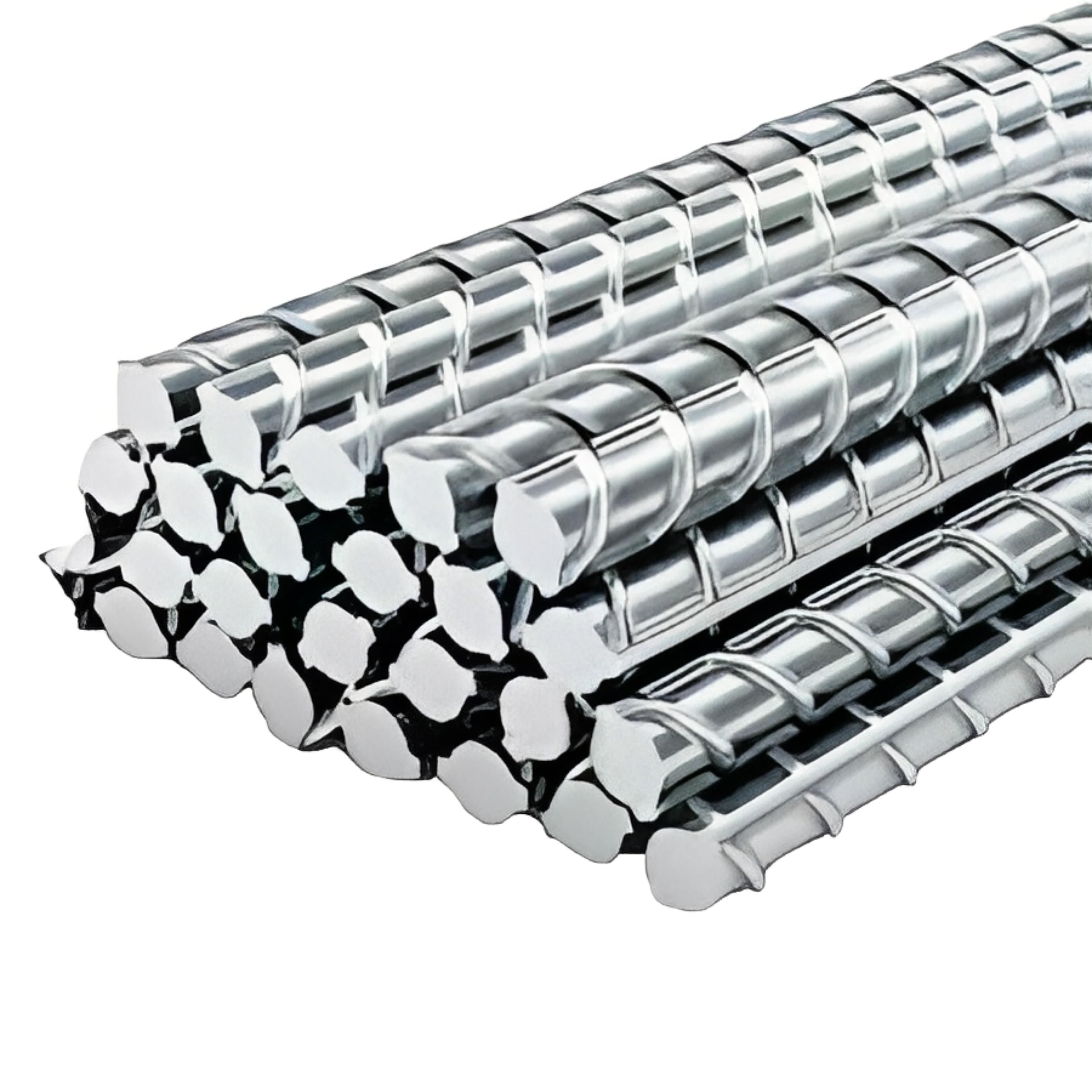Secondary TMT is produced through the electric arc (EA) and induction furnace (IF) route steel which melts scrap and sponge iron. The molten metal is cast into ...

Get Prices for Bulk Deals!
Secondary TMT Bytes
Similar Products
View MoreDaily Market Report
View MoreSecondary TMT Tenders
| Product | Location | Brand | Grade | Dimension | Price | Last Updated |
|---|---|---|---|---|---|---|
| Secondary TMT | Rourkela | Unspecified | Fe 500 | 10-25 mm | INR 38,800 /MT | 14 Dec 2025 |
| Secondary TMT | Rourkela | Unspecified | Fe 500 | 10-25 mm | INR 38,800 /MT | 13 Dec 2025 |
Secondary TMT (Thermo-Mechanically Treated) bars are widely used in construction projects where affordability matters a lot. These bars are typically sourced from rerolling mills that use scrap or excess primary steel, making them a budget-friendly alternative for general construction, small-scale projects, and infrastructure work.
While they may have slight variations in uniformity and chemical composition compared to primary TMT bars, they still provide excellent reinforcement for low- to mid-scale construction projects.
Secondary TMT bars are reinforcing steel bars produced by re-rolling scrap or ingots from induction furnaces, as opposed to primary TMT bars manufactured directly from iron ore in integrated steel plants. In India, the secondary steel sector plays a huge role in meeting the country's steel demand, particularly in the construction industry. Secondary TMT steel prices in India are comparatively lower than Primary TMT rates.
Key Properties of Secondary TMT
- Adequate Strength & Durability – While not as refined as primary TMT bars, they still meet general construction requirements.
- Cost-Effective Alternative – It is cheaper than primary TMT bars which is one big reason people prefer secondary TMT bars.
- Available in Various Grades – They are also available in different grades like Fe-415, Fe-500 and Fe-550. Different ones can be used for different levels of load-bearing in buildings.
- Good Weldability – They can be welded easily without losing too much strength, which helps in certain construction projects.
- Decent Corrosion Resistance – May lack advanced anti-corrosion coatings but can still withstand moderate environmental conditions.
Industrial Applications of Secondary TMT
1. Low-Rise Residential Buildings
For houses, small apartments, and low-rise structures, secondary TMT bars provide sufficient strength without high costs.
2. Rural and Semi-Urban Infrastructure
These bars are even used in road dividers, boundary walls, small bridges, and rural construction projects.
3. Warehouses and Temporary Structures
They are also used in non-load-bearing structures like sheds, warehouses, and temporary site offices.
4. General Fabrication & Miscellaneous Applications
These are good for small-scale fabrication works, fencing, and general reinforcement needs, too.
5. Small Commercial Buildings
Shops, godowns, and smaller office structures can use secondary TMT bars effectively.
Secondary TMT Market Trends and Supply Chain
The Indian steel industry is massive. It is, in fact, the world's second-largest. And the secondary steel sector contributes over 57% of the total domestic steel output. This part of the industry is growing as more people look for affordable options. There’s also been an increase in rural construction, which has pushed up demand for secondary TMT bars. Also, advancements in secondary steel manufacturing have enhanced the consistency of these bars.
The global TMT steel bar market is projected to reach USD 18.9–20.1 billion by 2030, growing at a CAGR of 9.4%, supported by sustained infrastructure investment and the superior strength, durability, and corrosion resistance of TMT bars compared to traditional reinforcement materials.
The secondary steel sector is collaborating with major industry players, contributing to capacity expansion and product diversification. Manufacturers like Sangam Steel are making the sector more competitive and meeting different kinds of demands. The Indian government has also been keeping an eye on the quality of secondary TMT bars. They’ve introduced regulations to classify manufacturers and improve standards for recycled steel.
India's TMT bar market has been seeing rapid growth because of the government's emphasis on infrastructure development and sustainable construction practices, which has also shown its impact on mild steel price per kg. In the fiscal year 2022-2023, India consumed approximately 50.3 million tons of TMT bars, which has gone up from 46 million tonnes in the previous fiscal year. Domestic manufacturers collectively produced 51 million tonnes of TMT bars in FY23, compared to 47.2 million tonnes in FY22. Steel demand has continued to rise in FY 2023–24 in line with a 13% jump in overall finished steel consumption to nearly 136 million tons.
Secondary TMT Prices
Now, let’s talk about steel price in India. Secondary TMT bar prices in India change depending on supplier, region, and grade. In the first quarter of 2025, Sangam secondary TMT rates ranged from ₹48,000 to ₹50,000 per metric ton for 12-25 mm bars. These rates fluctuate based on raw material costs, regional demand, and transportation charges.
Secondary TMT Historical Prices
Secondary TMT prices have fluctuated due to steel market conditions and scrap metal availability:
- 2023 Q1: ₹51,000/MT (High demand, stable prices)
- 2023 Q4: ₹47,000/MT (Scrap steel price decrease)
- 2024 Mid-Year: ₹53,100/MT (High demand from rural construction projects)
- 2024 December: ₹48,500/MT (Slight correction due to raw material price stabilisation)
Prices may continue to fluctuate based on global steel demand and domestic infrastructure activity.
Secondary TMT Rates Today
Current secondary TMT rates vary based on supply-demand balance, production costs, and regional factors. Buyers must stay updated on daily price trends through Nexizo to make better purchasing decisions. Prices may vary depending on supplier discounts, transportation costs, and bulk orders. Here you can also check the steel rate today to accordingly plan your purchase.
Secondary TMT Price Forecast
Looking ahead, secondary TMT prices are expected to either stay the same or go up slightly in the coming months. Affordable housing demand is increasing, especially with government-backed projects in rural areas. Global scrap steel prices will also influence secondary TMT costs. If scrap prices rise, production costs will follow. Seasonal factors matter too; during the monsoon season, construction slows down, which can cause temporary price dips. But in the long run, India’s focus on infrastructure development will keep demand high that will also affect steel rate.
Factors that Influence Secondary TMT Prices in India
The prices of secondary TMT bars depend on:
- Raw Material Availability – Secondary steel and MS steel price per KG fluctuate based on scrap and billet costs. If steel scrap and billet prices rise, so will TMT rates and MS steel price.
- Market Demand & Seasonal Trends – Construction booms during peak seasons drive up prices. Government plans for infrastructure projects like roads and railways pushes demand higher.
- Regional Demand – Prices vary based on local construction activities and infrastructure projects.
- Steel Market Trends – Prices align with global and domestic steel rates.
- Manufacturing Costs – Energy prices, labour wages, and operational expenses impact overall prices.
- Rerolling Mill Production – Quality and consistency depend on manufacturing processes.
- Regional Production & Supply – Availability of re-rolling mills in specific areas affects local pricing.
Get the Best Secondary TMT Prices Today on Nexizo
If you’re looking for the best prices on secondary TMT bars, Nexizo is the place to check, where today's steel price is also available. We provide real-time price updates, bulk order discounts, and delivery across India. Whether you’re a contractor, developer, or retailer, Nexizo provides you with quality secondary TMT bars. You can track live prices, find bulk order deals, and get fast delivery.
For anyone working in construction, secondary TMT bars offer a balance between strength, affordability, and sustainability. They might not be the absolute best, but they get the job done for many types of projects.

%2Fhttps%253A%252F%252Fofbadmin.s3.ap-southeast-1.amazonaws.com%252Fnexizo%252Fproduction%252Fstrapi%252FTMT_Fe_550_D_d1944141c6.png&w=3840&q=75)
%2Fhttps%253A%252F%252Fofbadmin.s3.ap-southeast-1.amazonaws.com%252Fnexizo%252Fproduction%252Fstrapi%252Fhot_rolled_steel_coil_roll_o0_Q4an9_600_fe306f6654.jpg&w=3840&q=75)
%2Fhttps%253A%252F%252Fofbadmin.s3.ap-southeast-1.amazonaws.com%252Fnexizo%252Fproduction%252Fstrapi%252FCRC_cec6577b20.png&w=3840&q=75)
%2Fhttps%253A%252F%252Fofbadmin.s3.ap-southeast-1.amazonaws.com%252Fnexizo%252Fproduction%252Fstrapi%252FHR_Plate_4c9d03721e.png&w=3840&q=75)
%2Fhttps%253A%252F%252Fofbadmin.s3.ap-southeast-1.amazonaws.com%252Fnexizo%252Fproduction%252Fstrapi%252FGI_Coil80_GSM_0_80mm_050acad7cb.png&w=3840&q=75)
%2Fhttps%253A%252F%252Fofbadmin.s3.ap-southeast-1.amazonaws.com%252Fnexizo%252Fproduction%252Fstrapi%252Ftmt_1_1a98e45017.png&w=3840&q=75)
%2Fhttps%253A%252F%252Fofbadmin.s3.ap-southeast-1.amazonaws.com%252Fnexizo%252Fproduction%252Fstrapi%252Ftmt_2_5a918fa09f.png&w=3840&q=75)
%2Fhttps%253A%252F%252Fofbadmin.s3.ap-southeast-1.amazonaws.com%252Fnexizo%252Fproduction%252Fstrapi%252Fstainless_steel_4_5c962d3e80.png&w=3840&q=75)
%2Fhttps%253A%252F%252Fofbadmin.s3.ap-southeast-1.amazonaws.com%252Fnexizo%252Fproduction%252Fstrapi%252FMild_Steel_4ea69f4691.png&w=3840&q=75)
%2Fhttps%253A%252F%252Fofbadmin.s3.ap-southeast-1.amazonaws.com%252Fnexizo%252Fproduction%252Fstrapi%252Ftmt_3f051e2fb7.png&w=3840&q=75)
%2Fhttps%253A%252F%252Fofbadmin.s3.ap-southeast-1.amazonaws.com%252Fnexizo%252Fproduction%252Fstrapi%252Ftmt_4_855334dcb0.png&w=3840&q=75)